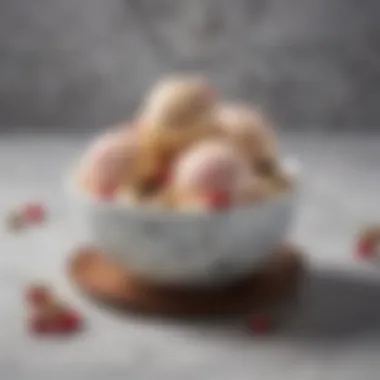Exploring Marble Ice Cream: A Culinary Delight


Intro
Marble ice cream stands out as a distinctive frozen dessert that marries two flavors into a visually captivating blend. This delightful treat is more than just its aesthetic appeal; it carries a rich history and a multitude of techniques that contribute to its unique flavors. Marble ice cream invites culinary enthusiasts and casual food lovers alike to explore its complexities. Through this exploration, we aim to uncover the scientific principles behind achieving the perfect swirl and the cultural significance associated with this favorite indulgence.
Recipe Overview
Marble ice cream typically combines two different flavors, usually a rich chocolate intertwined with creamy vanilla. The technique of swirling the two flavors together creates both a visual and taste delight. This dessert is perfect for various occasions, from casual gatherings to festive celebrations.
Ingredients List
- 2 cups heavy cream
- 1 cup whole milk
- 3/4 cup granulated sugar
- 1 teaspoon pure vanilla extract
- 1/2 cup unsweetened cocoa powder
- 1/2 cup chocolate syrup
- Pinch of salt
Step-by-Step Cooking Instructions
- Prepare the base: In a mixing bowl, combine the heavy cream, whole milk, sugar, and a pinch of salt. Whisk until the sugar dissolves completely.
- Create the chocolate mixture: In another bowl, mix cocoa powder with a small amount of the cream base to form a smooth paste before combining with the rest of the cream mixture.
- Chill the mixture: Place both mixtures in the refrigerator for about 30 minutes to chill. This step helps in the churning process.
- Churn the ice cream: Using an ice cream maker, churn the chilled base according to the manufacturer's instructions. Churn until it reaches a thick, soft-serve consistency.
- Layer and swirl: In a freezer-safe container, alternate layers of the vanilla and chocolate mixtures. Use a knife or spatula to gently swirl the layers together.
- Freeze until firm: Cover the container and freeze for at least 4 hours or until it reaches your desired firmness.
- Tip: Use room temperature milk for easier blending.
- Tip: Ensure there are no lumps in the cocoa mixture to maintain a smooth consistency.
- Tip: Cold mixtures churn better, resulting in creamier ice cream.
- Tip: Do not over-churn, or it might become too firm too soon.
- Tip: Be careful not to over-mix; you want distinct swirls for aesthetic appeal.
- Tip: Allow it to soften slightly at room temperature before serving for easier scooping.
Marble ice cream, with its dual flavors and textures, not only satisfies the palate but also captivates the eye, making it a favorite among frozen desserts.
By delving into the art and science of marble ice cream, we find a harmonious blend of flavors, creativity, and tradition.
Prolusion to Marble Ice Cream
Marble ice cream stands out as a unique expression of flavor and texture within the realm of frozen desserts. This section aims to set the stage for understanding the key aspects of marble ice cream, including its definition, characteristics, and historical contexts. By exploring these elements, readers can appreciate not only the product itself but also the labor and creativity that go into crafting this beloved treat.
Definition and Characteristics
Marble ice cream is defined by its distinctive swirling patterns that combine two or more flavors. Typically, this dessert features a creamy base that may include vanilla, chocolate, or fruit-infused mixtures, expertly blended to create an appealing visual effect. The marbling technique allows for a beautiful presentation and an exciting tasting experience.
The physical characteristics of marble ice cream include a smooth texture and a rich flavor profile. Unlike traditional ice cream, the marbled version offers a delightful contrast between the different flavors, making each spoonful a unique experience. The interplay of flavors provides a sensory richness that engages both the palate and the eyes, making it a highly sought-after dessert.
Historical Background
The history of marble ice cream is intertwined with the evolution of ice cream itself. It is thought that as ice cream gained popularity in the 18th century, creative minds began to experiment with combining flavors. The introduction of new ingredients and flavors further inspired the marbling technique.
Documents suggest that marble ice cream began to appear in various forms in Europe and North America during the late 19th century. Its accessibility and ability to cater to different tastes contributed to its rise in popularity. As ice cream parlors flourished, so did the desire for variety and visual appeal, solidifying marble ice cream's place in culinary tradition.
Today, marble ice cream not only captivates with its aesthetic beauty but also serves as a testament to the innovation and artistry that define the world of ice cream. This dessert has evolved through time, adapting to current trends and preferences while remaining a timeless classic.
Making Marble Ice Cream
Making marble ice cream is a central aspect of this article. Understanding the preparation process reveals how ingredients combine to create unique textures and flavors. This section will discuss the essential components, preparation methods, and the tools required to craft this delightful frozen treat. Delving into these details enhances appreciation for marble ice cream, appealing to both novice and experienced culinarians.


Essential Ingredients
The foundation of marble ice cream lies in its ingredients. Basic elements include cream, sugar, and flavorings. Cream provides richness and contributes to the desired smooth texture. Sugar not only sweetens but also affects the freezing point, ensuring the ice cream remains scoopable.
Flavorings are where creativity begins. Common choices are chocolate, vanilla, and fruit purees. Each flavor brings its profile, creating a harmonious blend when swirled together. High-quality ingredients improve the final product significantly, making them a critical consideration.
Preparation Methods
Preparation methods can vary, but the techniques employed determine the quality of the marble effect.
Churning Techniques
Churning techniques are vital in developing texture. The process introduces air into the mixture, resulting in a lighter consistency. A standard method is using an ice cream maker, which churns continuously as it freezes the mixture. This is a popular choice, as it allows for controlled temperature and consistent results.
Churning helps emulsify ingredients, ensuring even flavor distribution. However, over-churning can lead to a grainy texture, undermining the smoothness associated with marble ice cream.
Freezing Process
The freezing process is equally important. After churning, the ice cream needs sufficient time to harden. Many recipes recommend transferring the churned mixture to a lidded container and letting it freeze for several hours. This step solidifies the texture and aids in flavor development.
Temperature control during this stage is crucial. If the ice cream freezes too quickly, it can develop ice crystals, affecting the overall quality. Conversely, a gradual freeze helps create a silkier texture.
Mixing Flavors
Mixing flavors requires a delicate touch. This process involves folding one flavor into another, creating that signature marbling effect. It's essential to achieve an even distribution without fully blending the flavors.
One effective method is to layer the flavors in the container. By spooning layers of different flavors and lightly swirling with a spatula, a pleasing visual and taste experience emerges. This technique highlights the unique character of each flavor while maintaining the beautiful marble appearance.
Tools and Equipment
Essential tools for making marble ice cream include an ice cream maker, mixing bowls, and a spatula. An ice cream maker facilitates the churning and freezing, making the process more manageable. Mixing bowls allow for combined flavors before transferring to a container. A spatula is ideal for carefully marbling flavors and completing the final mixing process.
With the right ingredients and methods, anyone can create their version of marble ice cream. Understanding these processes provides a clearer view of this culinary delight.
Flavor Profiles in Marble Ice Cream
The flavor profiles in marble ice cream are crucial to its appeal. A well-crafted marble ice cream encapsulates not just taste, but an entire sensory experience that resonates with food lovers. The richness of flavor can elevate the simple act of enjoying ice cream into a memorable moment. Additionally, the various flavor combinations cater to diverse palates, making marble ice cream an inclusive dessert choice.
Traditional Flavors
Traditional flavors in marble ice cream highlight the classic tastes that many people adore. These flavors often include chocolate, vanilla, and strawberry. Each serves as a fundamental building block in this dessert. Chocolate ice cream adds a rich, deep flavor profile, while vanilla provides a smooth, creamy foundation. Strawberry, with its fruity brightness, can cut through the richness.
These flavors meld together in a way that creates contrasts in taste and texture. For instance, when chocolate and vanilla are swirled, the combination brings out the best of both worlds. It is common to see these flavors featured in ice cream shops worldwide. This ubiquity is a testament to their timelessness.
Innovative Combinations
In recent years, innovative combinations have emerged, redefining how marble ice cream is perceived. Flavors like salted caramel, pistachio, and raspberry ripple are becoming increasingly popular. Salted caramel’s sweet yet slightly savory notes add complexity. Meanwhile, pistachio introduces a nutty flavor that resonates with many.
Raspberry ripple brings a tart contrast, balancing sweetness with its zesty notes. These innovative combinations reflect culinary creativity, showcasing that marble ice cream can also be a canvas for modern flavors. The flexibility in flavor integration encourages both amateur and professional ice cream makers to experiment, pushing the boundaries of what can be achieved.
Seasonal Variations
Seasonal variations of marble ice cream provide another layer of enjoyment. Flavors can change based on seasonal ingredients. In summer, you might find refreshing lemon or peach marble ice cream, whereas autumn could see pumpkin spice or apple cinnamon. Using seasonal produce not only enhances flavor profiles but also promotes sustainability.
The beauty of seasonal variations lies in their timeliness. As a food lover, indulging in seasonal flavors can create a connection with the time of year. It allows for a more immersive experience, making each bowl of marble ice cream special depending on the season.


The Science of Marbling
The intricate process of marbling in ice cream is not just for aesthetics; it plays a crucial role in the texture and flavor experience. Understanding the science behind marbling allows both home cooks and professional chefs to enhance their creations. When executed expertly, marbling offers a delightful visual appeal while also providing a harmonious blend of flavors. The goal is to achieve a perfect swirl that captivates the eye and pleases the palate.
Understanding Emulsification
Emulsification is the process of combining ingredients that typically do not mix well, such as fat and water. In marble ice cream, emulsification is key. Ice cream consists of cream, milk, and sugar, which need to be properly emulsified to achieve a smooth texture.
The presence of emulsifiers, like egg yolks or commercial emulsifying agents, helps stabilize the mixture. This is crucial because it allows the fat to distribute evenly throughout the ice cream base, preventing the formation of ice crystals. An efficiently emulsified base results in a richer mouthfeel and enhances flavor release.
This aspect of emulsification is particularly significant in marble ice cream, as the different flavors typically have distinct fat contents. If the emulsification is not handled well, the distinct flavors may not blend effectively, leading to a less enjoyable eating experience.
Achieving the Perfect Swirl
The art of marbling is in the swirl. Achieving this visually appealing pattern involves control techniques that ensure flavors combine without losing their identity. Two critical aspects in achieving the perfect swirl are temperature control and mixing techniques.
Temperature Control
Temperature control in the ice cream-making process is vital for achieving the ideal texture and marbling effect. Ice cream mixtures need to be at specific temperatures for different stages of preparation. Too warm of a mixture will not hold its shape during swirling, while too cold can lead to harsh textures.
Key aspects of temperature control include:
- Consistency: Maintaining a consistent temperature during the mixing and freezing stages ensures that the ice cream holds its swirl.
- Flavor Integrity: Different ingredients may require different temperatures to express their flavors. For example, chocolate might need a cooler environment compared to fruit purees.
This is a beneficial choice for marble ice cream because it allows for more vibrant flavors and a stable product. However, if not managed carefully, it can lead to ineffective marbling where flavors blend too much or do not swirl at all.
Mixing Techniques
Mixing techniques are essential for achieving the desired marble effect. This involves not just the timing, but also the method of introducing the flavors into the base. For example, folding in the flavor components carefully ensures that each component retains its distinctiveness while still appearing harmoniously swirled.
Key features of effective mixing techniques include:
- Folding: This gentle method helps maintain the integrity of each flavor and the overall texture.
- Swirling vs. Stirring: Swirling encourages a better visual marbleization than stirring, which can blend ingredients too thoroughly.
These techniques are popular choices in marble ice cream production as they allow for effectiveness in achieving that perfect visual swirl while still providing a diverse flavor experience.
Cultural Significance
Understanding the cultural significance of marble ice cream offers insight into how this dessert transcends mere indulgence. Marble ice cream holds a place in various culinary traditions worldwide, reflecting local flavors, preferences, and even social practices. Its unique appeal lies in its ability to blend flavors harmoniously while still allowing individual taste components to shine through. This duality is not just a culinary feat; it also symbolizes cultural fusion, representing the blending of diverse culinary heritages.
Regional Variations of Marble Ice Cream
Marble ice cream is not monolithic; it flourishes in various forms depending on the region. For instance, in Italy, gelato makers often emphasize local ingredients, resulting in distinct flavor profiles that represent the area’s agricultural offerings. Pistachio and hazelnut meld beautifully with rich chocolate to create a variation that expresses both local pride and culinary innovation.
In the United States, seasonal fruit flavors dominate during the summer months. Flavors such as raspberry and peach often intertwine with creamy vanilla, creating a visually appealing and refreshing dessert. This not only encourages a connection with seasonal produce but also reflects a broader trend toward embracing local cuisine and sustainable practices.
Additionally, Asian cultures interpret marble ice cream in unique ways. For example, in certain regions of Japan, green tea ice cream may be swirled with sweet red bean paste, creating a blend that beautifully balances earthy and sweet elements. This is not just about flavors; it’s also about heritage and the ways in which ingredients embody cultural narratives.
Marble Ice Cream in Popular Culture
The presence of marble ice cream in popular culture is significant. It appears in films, television shows, and even literature, often used to evoke nostalgia or comfort. Its marbled appearance has become emblematic of indulgence and celebration. In many family gatherings and milestone events, marble ice cream is a staple, reinforcing its association with joyful moments.
Social media also plays a part in elevating marble ice cream’s cultural status. Aesthetic food photography promotes homemade variations, helping to create community around this popular dessert. Hashtags feature visual candies, celebrating the beautiful outcomes of homemade culinary adventures.
The significance of marble ice cream goes beyond taste; it creates connections, celebrates traditions, and reflects the diversity of our culinary landscape.


In summary, marble ice cream serves as a bridge that links individual tastes with cultural narratives. Whether one is enjoying it at a local parlor, preparing it at home, or sharing it with friends and family, this dessert embodies a rich tapestry of history, innovation, and community.
Nutritional Aspects
Understanding the nutritional aspects of marble ice cream is vital for anyone looking to enjoy this dessert mindfully. While it is often a beloved treat, being aware of its caloric content and its ingredients allows consumers to make informed choices. Additionally, recognizing healthier alternatives can help fulfill one’s sweet tooth without sacrificing health goals. This section will address these important components to provide a comprehensive view of what marble ice cream entails nutritionally.
Caloric Content and Ingredients
The caloric content of marble ice cream can vary significantly depending on ingredients and preparation methods. Typically, a serving of marble ice cream can contain between 150 to 300 calories. The main contributors to this caloric value include:
- Sugar: Often, marble ice cream includes a substantial amount of sugar, which enhances flavor but also adds to the caloric count.
- Milk: The type of milk used, whether whole milk, cream, or plant-based alternatives, affects both calories and fat content.
- Flavorings: Additional flavorings like chocolate or caramel not only enrich the taste but also contribute to the overall calorie content.
Ingredients such as emulsifiers and stabilizers may also be present in commercial versions, impacting both texture and nutritional profile. Homemade versions, prepared using fresh ingredients, can offer better control over what goes into the mixture. Keeping track of these elements is essential, especially for those managing daily caloric intake and dietary restrictions.
Healthier Alternatives
For those who love marble ice cream but seek healthier options, several alternatives exist:
- Low-fat versions: These reduce calorie intake without completely sacrificing the creaminess and flavor, often substituting some cream with low-fat milk or yogurt.
- Natural sweeteners: Utilizing honey, agave syrup, or stevia can lower caloric content while providing sweetness.
- Non-dairy alternatives: Options like almond milk or coconut milk base not only cater to lactose intolerance but can also be lower in calories.
These alternatives can provide similar satisfaction while aligning better with dietary goals. Health-conscious food lovers can still enjoy the delightful taste without compromising nutrition.
"Alternative ingredients can transform marble ice cream into a treat both satisfying and mindful of health objectives."
By understanding the nutritional facts, individuals can enjoy marble ice cream in moderation, making choices that align with their health and wellness goals.
Serving and Pairing Suggestions
When discussing marble ice cream, serving and pairing suggestions are crucial. They enhance the overall experience of enjoying this unique dessert. A well-served portion can accentuate its visual appeal and flavor profile, allowing the intricate marbling to shine. Additionally, the right pairings can elevate the taste, bringing out the nuances of both the ice cream and the accompanying foods or drinks.
Best Practices for Serving
Serving marble ice cream correctly can be the difference between a simple treat and a gourmet experience. Here are some best practices:
- Temperature Matters: Serve marble ice cream just below freezing. This ensures it retains its shape without becoming too soft. A slight thaw improves texture and flavor.
- Presentation: Use clear bowls or plates to showcase the beautiful marbled swirls. This visual appeal adds to the overall enjoyment.
- Quantity Control: Serve moderate portions. A little goes a long way with rich flavors. Consider 1/2 to 1 cup servings, depending on accompanying items.
- Garnish Thoughtfully: Consider topping with ingredients like fresh fruit, chocolate shavings, or a drizzle of sauce. These additions complement the ice cream’s flavor and enhance aesthetics.
Complementary Foods and Drinks
Pairing marble ice cream with the right foods and drinks complements its flavors and textures. Here are some thoughtful suggestions:
- Fruits: Fresh berries, bananas, or citrus fruits contrast nicely with the creaminess of marble ice cream. They provide a refreshing balance.
- Baked Goods: Serving with cookies, brownies, or a slice of pie adds a delightful texture. Chocolate chip cookies or warm brownies work particularly well.
- Sauces: A drizzle of caramel or dark chocolate sauce can enhance the richness. These sauces can echo the flavors within the ice cream itself.
- Beverages: Pair with a hot beverage, like coffee or espresso, for a delightful contrast in temperatures and flavors. For a non-caffeinated option, a fizzy fruit soda can complement the creaminess.
A thoughtful pairing can enhance the culinary experience, allowing the eater to discover new textures and flavors.
In summary, marble ice cream deserves careful attention when serving. The right practices not only make the treat enjoyable but also memorable, encouraging both aesthetic appreciation and flavorful exploration.
Epilogue
Marble ice cream is more than just a delicious dessert; it is a blend of history, culture, and science. This article has outlined essential aspects of marble ice cream, highlighting not only its flavors and preparation methods but also its significance in various cultures. Understanding these aspects adds value to the appreciation of such a culinary delight.
One considerable benefit of knowing about marble ice cream is recognizing the versatility it offers. Its unique marbling technique opens doors to endless flavor combinations and innovative recipes. Enthusiasts can experiment with personal creations, finding joy in the intricate processes involved.
Moreover, the exploration of nutritional aspects is crucial. Given today's health-conscious climate, knowing the caloric content and alternatives can help consumers make informed choices. This is especially important when indulging in sweets like ice cream, where balance is essential.
Final Thoughts on Marble Ice Cream
Marble ice cream captivates the senses and ignites creativity in the kitchen. It serves as a canvas that invites exploration and experimentation, making it a cherished item in both commercial and home kitchens. The art of marbling not only results in stunning presentations but also allows for palate surprises with each spoonful.
As we move forward, the enjoyment of marble ice cream can be enhanced through understanding and appreciation for its production. From the choice of ingredients to the methods of preparation, every step adds to the overall experience.
Whether enjoyed on a hot summer day or as a comforting treat during colder months, marble ice cream continues to evoke feelings of joy and nostalgia. Embracing this dessert means appreciating its history, creation, and the pleasure it brings to countless people worldwide. Each time one savors a scoop, it is a reminder of the artistry and love that goes into this culinary delight.







